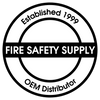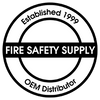The Origin of the Fire Extinguisher: A Lifesaving Invention Through Time
Posted by the FSS Team on Oct 1st 2024
Fire extinguishers are indispensable safety tools found in homes, offices, and public spaces worldwide. But few people know the history behind this essential invention, which stretches back over 300 years. The development of the fire extinguisher marks a significant progression in humanity's ongoing efforts to manage and control fire, a force that has been both vital and dangerous since the dawn of civilization.
Early Concepts: The First Fire Extinguisher (1723)
The first known fire extinguisher was developed in 1723 by Ambrose Godfrey, a German chemist based in England. Godfrey’s invention was a rudimentary yet clever device, consisting of a barrel filled with a fire-extinguishing liquid and a small charge of gunpowder. When the gunpowder ignited, it would explode, breaking the barrel and spreading the liquid to douse the fire. Although this was far from the modern handheld extinguishers we know today, it demonstrated the early recognition of the need for portable fire suppression.
While Godfrey’s design was not widely adopted for everyday use, it laid the groundwork for future innovations. His invention was mainly used in larger facilities where fire hazards were common, such as factories and large public buildings.
The Birth of the Modern Fire Extinguisher (1818)
The first version of the portable fire extinguisher, as we know it today, was invented nearly a century later in 1818 by Captain George William Manby, a British inventor. Manby’s fire extinguisher consisted of a copper container filled with a pressurized solution of potassium carbonate (a chemical compound known to suppress fire). The extinguisher was equipped with compressed air, which allowed the user to aim and discharge the liquid onto a fire.
This was a revolutionary improvement over previous methods, which required large quantities of water or cumbersome equipment. Manby’s design was more practical for everyday use and marked the beginning of a new era in fire safety.
Technological Advancements: CO2 and Chemical Fire Extinguishers
Following Manby’s innovation, the fire extinguisher continued to evolve as new materials and scientific knowledge became available. By the late 19th and early 20th centuries, new types of extinguishers were developed to address specific types of fires.
One major development came in 1912, when Walter Kidde, an American businessman, pioneered the use of carbon dioxide (CO2) as a fire suppressant. CO2 extinguishers were effective in smothering fires by displacing oxygen, making them particularly useful for electrical fires, which couldn’t be extinguished by water.
In the mid-20th century, dry chemical extinguishers were introduced. These extinguishers used powders like sodium bicarbonate, which could suppress Class B and C fires (involving flammable liquids and electrical equipment). This innovation further expanded the versatility and application of fire extinguishers.
Standardization and Modern Usage
As the design and technology of fire extinguishers improved, so did the understanding of different types of fires. In the mid-1900s, fire safety authorities began classifying fires into categories (A, B, C, D, and K), each requiring specific types of extinguishers for maximum effectiveness. This classification system led to the development of specialized extinguishers, including foam, water, dry chemical, and CO2-based models, each suited to particular fire types.
Today, fire extinguishers are standardized safety equipment in most countries, with clear guidelines for their use and maintenance. Portable fire extinguishers are now designed to be user-friendly, lightweight, and effective in suppressing small fires before they spread out of control.
The Impact of the Fire Extinguisher on Modern Safety
The invention and continual development of the fire extinguisher have saved countless lives and properties over the centuries. Fire extinguishers are now an essential component of building safety codes and fire prevention strategies worldwide. Their effectiveness in containing small fires has dramatically reduced the number of large-scale disasters.
Additionally, the introduction of training programs on how to properly use fire extinguishers has empowered individuals and communities to take immediate action during fire emergencies.
The fire extinguisher's origin is a testament to human ingenuity and the drive to overcome the dangers posed by fire. From Ambrose Godfrey’s explosive device in the 18th century to the sophisticated, multi-functional extinguishers of today, this life-saving tool has undergone significant transformation. As fire safety technology continues to evolve, the fire extinguisher remains a vital part of fire prevention and protection strategies in both public and private settings.
 Since 1999, Fire Safety Supply has been the go-to for fire suppression products, industrial dry chemical systems, high and low-pressure CO2, vehicles, and clean agents. We serve various types of industries such as restaurants, commercial kitchen, wineries, and more.
Since 1999, Fire Safety Supply has been the go-to for fire suppression products, industrial dry chemical systems, high and low-pressure CO2, vehicles, and clean agents. We serve various types of industries such as restaurants, commercial kitchen, wineries, and more.
